Abstract
1. The milk ejection reflex in response to suckling was studied in conscious sows by continuous recording of intramammary pressure, radioimmunoassay of plasma concentrations of neurohypophysial hormones, and observation of the behaviour of the sows and piglets.
2. A regular pattern of nursing, suckling and milk ejection was observed. The mean duration of the suckling period was 6·3 min. Over 144 suckling periods, 113 milk ejections were recorded. Each milk ejection was characterized by a sudden rise in intramammary pressure reaching 20-49 mmHg, and lasting 8-41 sec. Milk ejections occurred only once per suckling period, at a mean interval of 44·3 min.
3. Each milk ejection occurred with a mean latency of 2·4 min from the onset of a period of initial massage of the udders by the piglets, and was coincident with a period of quiet suckling when the piglets were consuming milk. The onset of nursing was signalled by the sows grunting in a rhythmic manner. In most cases, the frequency of grunts, at first low, increased suddenly 23 sec before milk ejection.
4. During eighteen suckling periods leading to milk ejection, neurohypophysial hormone assays performed on serial blood samples showed an increase in plasma concentration of oxytocin up to 30 sec before milk ejection. The concentration of lysine—vasopressin did not rise above basal levels.
5. In 21·4% of the suckling periods, no rise in intramammary pressure was observed. In these `incomplete sucklings', the sow usually failed to grunt rapidly, and the piglets obtained no milk. For three of these periods, hormone assay showed no increase in oxytocin or vasopressin concentrations in blood.
6. Oxytocin given intravenously produced variations in intramammary pressure which depended on the dose and the rate of injection. Rapid injections of 25-50 m-u. oxytocin, caused milk ejections similar to those induced by suckling. When oxytocin was administered at different rates, the faster the injection, the shorter the latency and the higher the amplitude of the response. Plasma concentrations of oxytocin after injection of 25 m-u. were similar to those observed during reflex milk ejection.
7. Trains of electrical pulses were applied to the posterior pituitary of four anaesthetized sows. At frequencies of stimulation above 10 Hz, a rise in intramammary pressure and an increase in plasma oxytocin and vasopressin concentrations were observed. At frequencies of stimulation of 30-50 Hz, the response of the mammary gland and the time course of the variations in oxytocin plasma concentrations were similar to those observed during natural reflex milk ejection.
8. It is concluded that reflex milk ejections during suckling in the pig are caused by the intermittent and spurt-like release of about 25 m-u. oxytocin, without concomitant vasopressin release. It is postulated that the release of oxytocin is probably precipitated by a brief and massive activation of oxytocin-secreting neurones in the hypothalamus. Central mechanisms controlling the intermittent release of oxytocin are discussed.
Full text
PDF

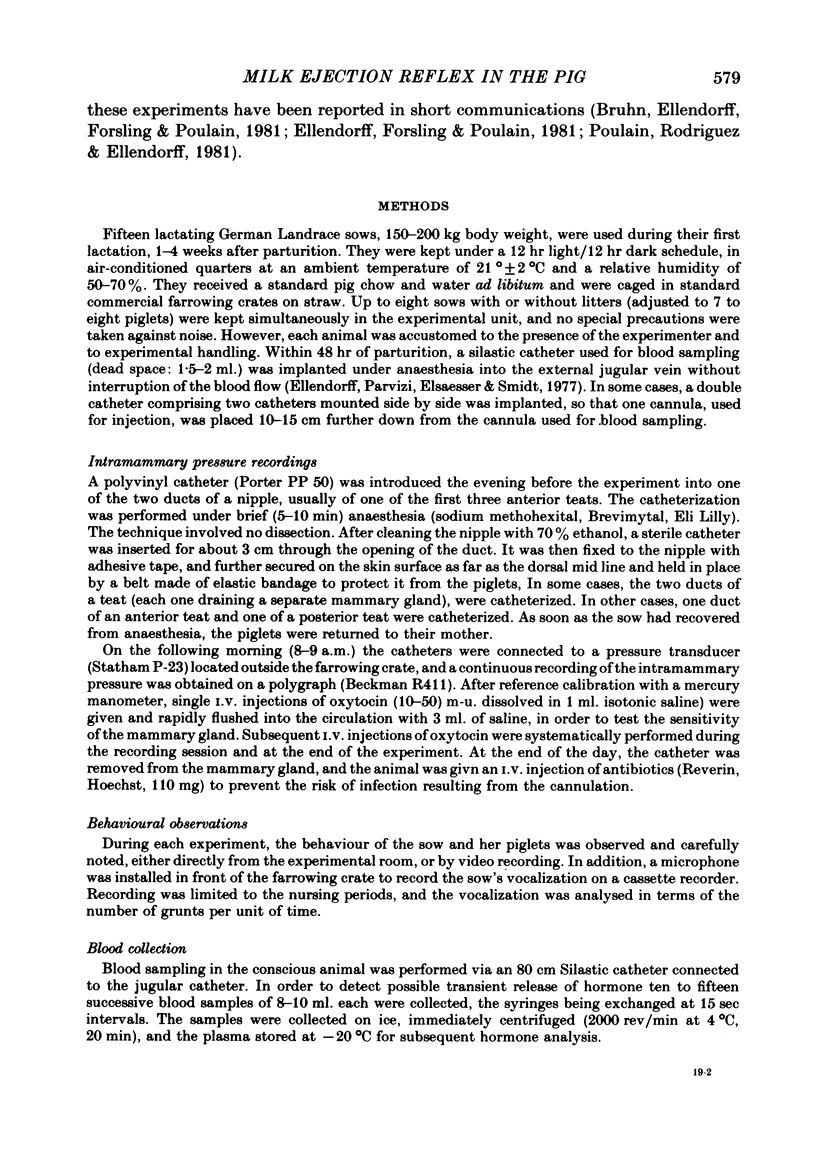
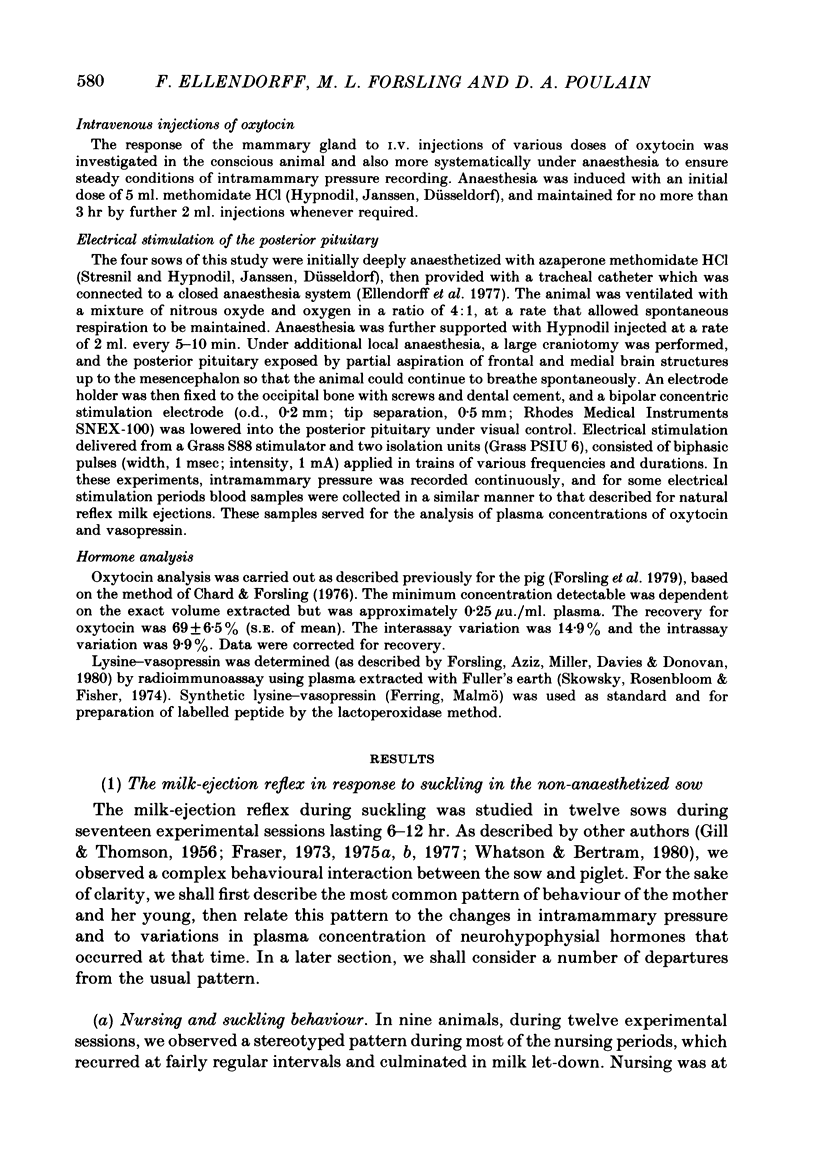
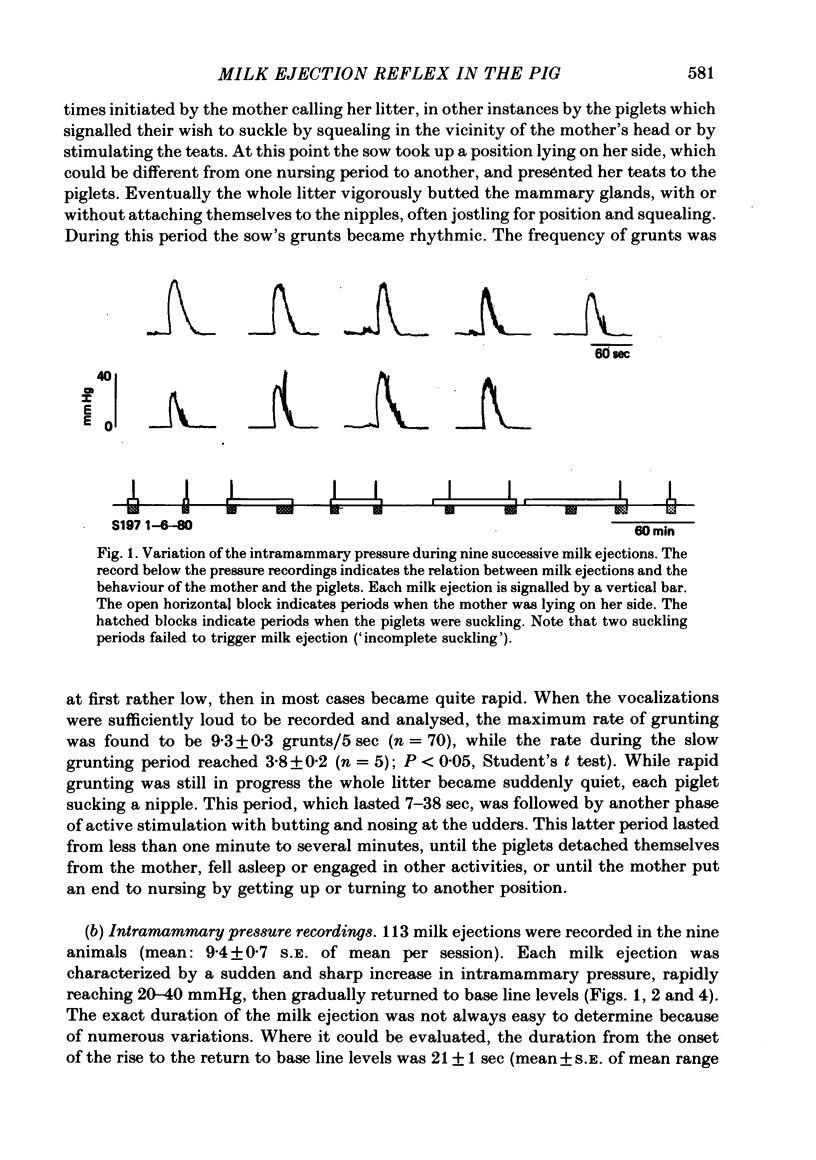

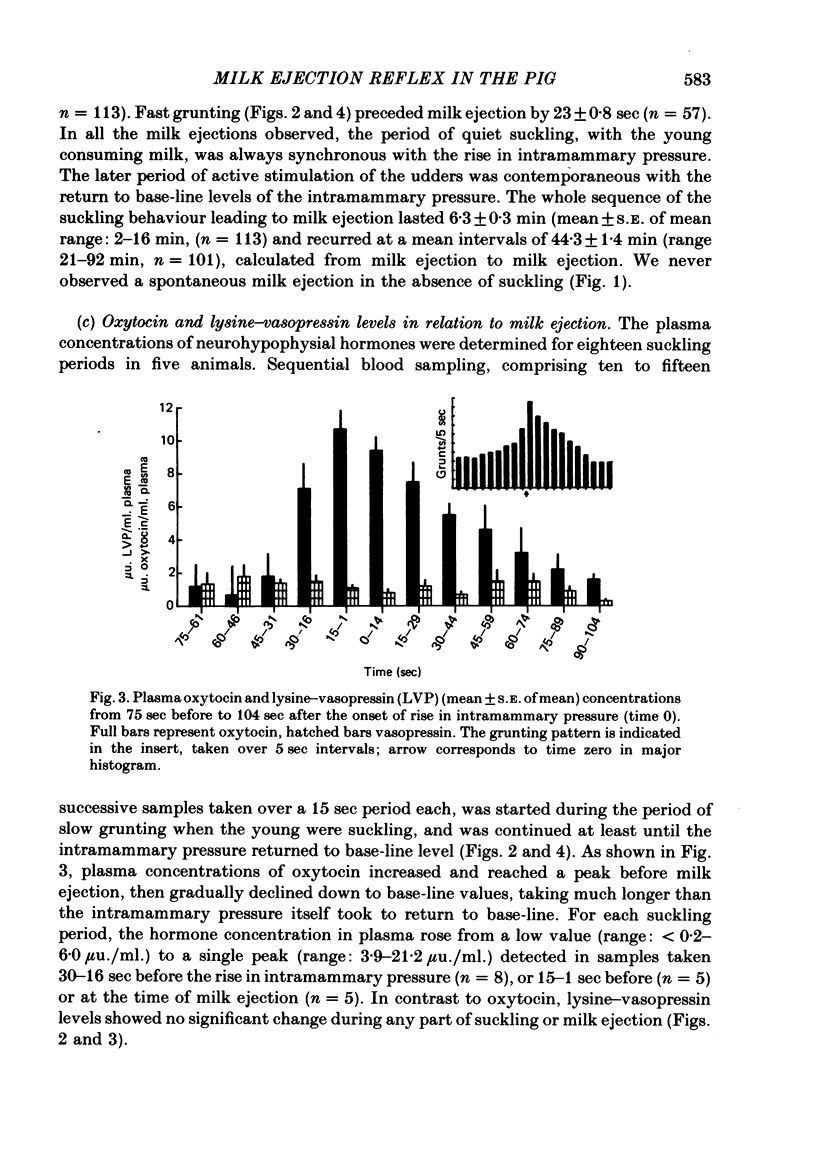
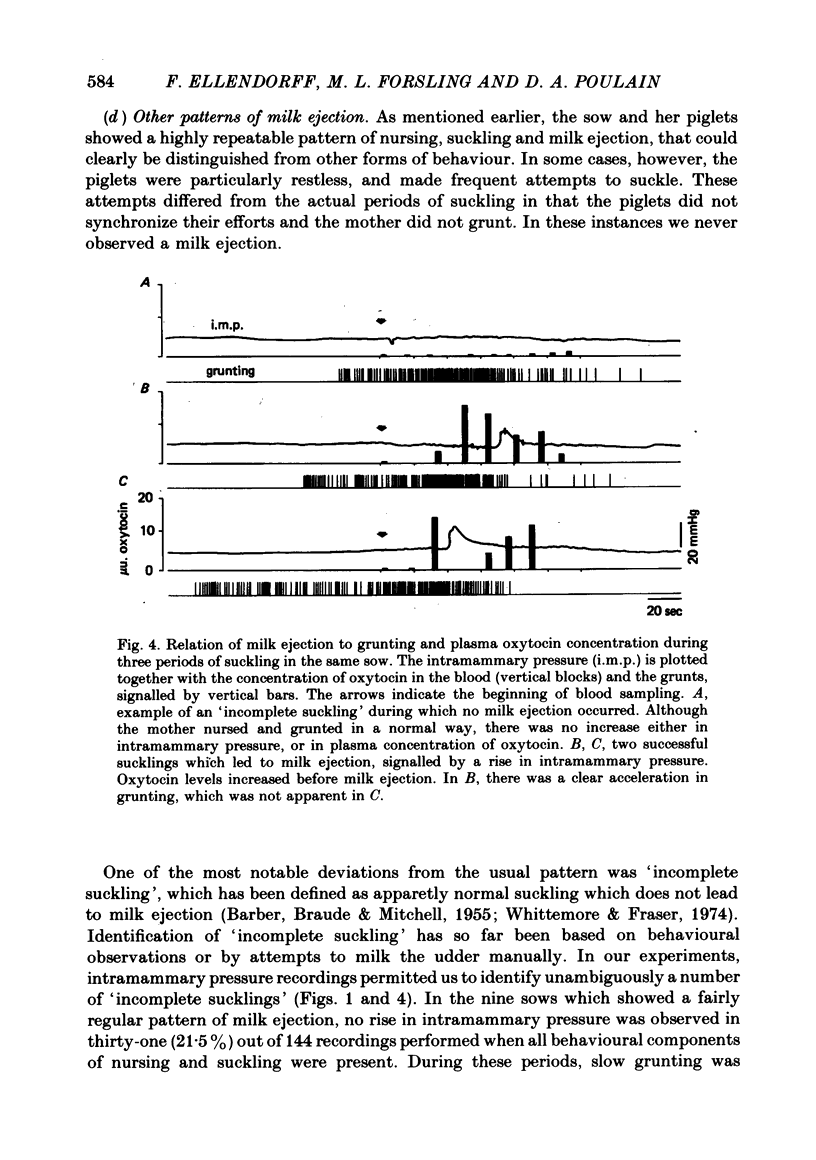
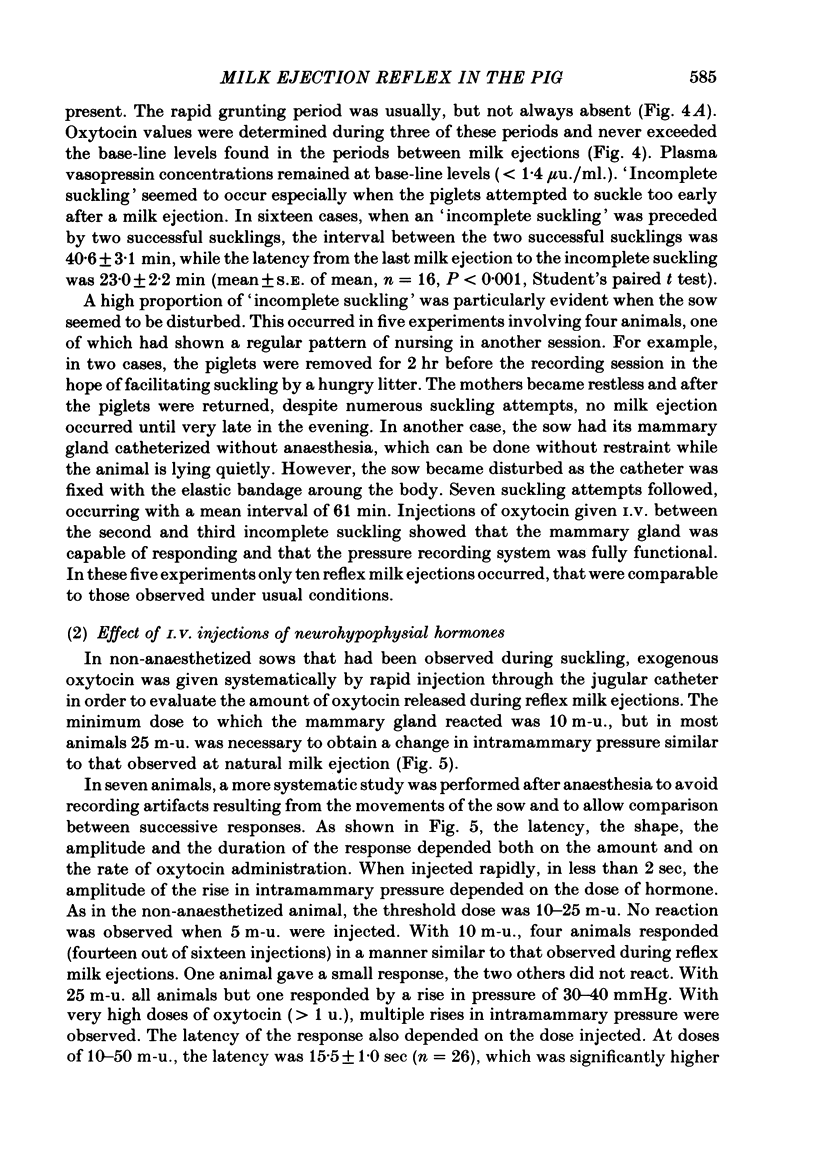





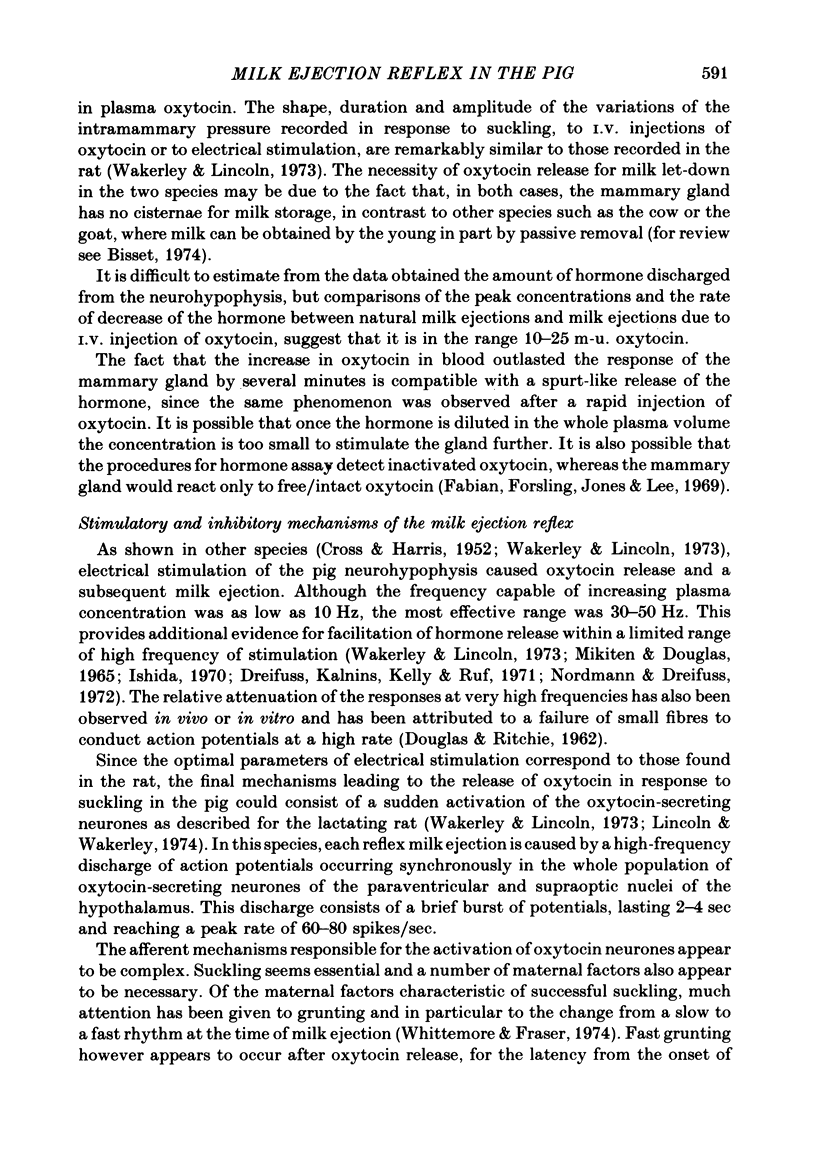
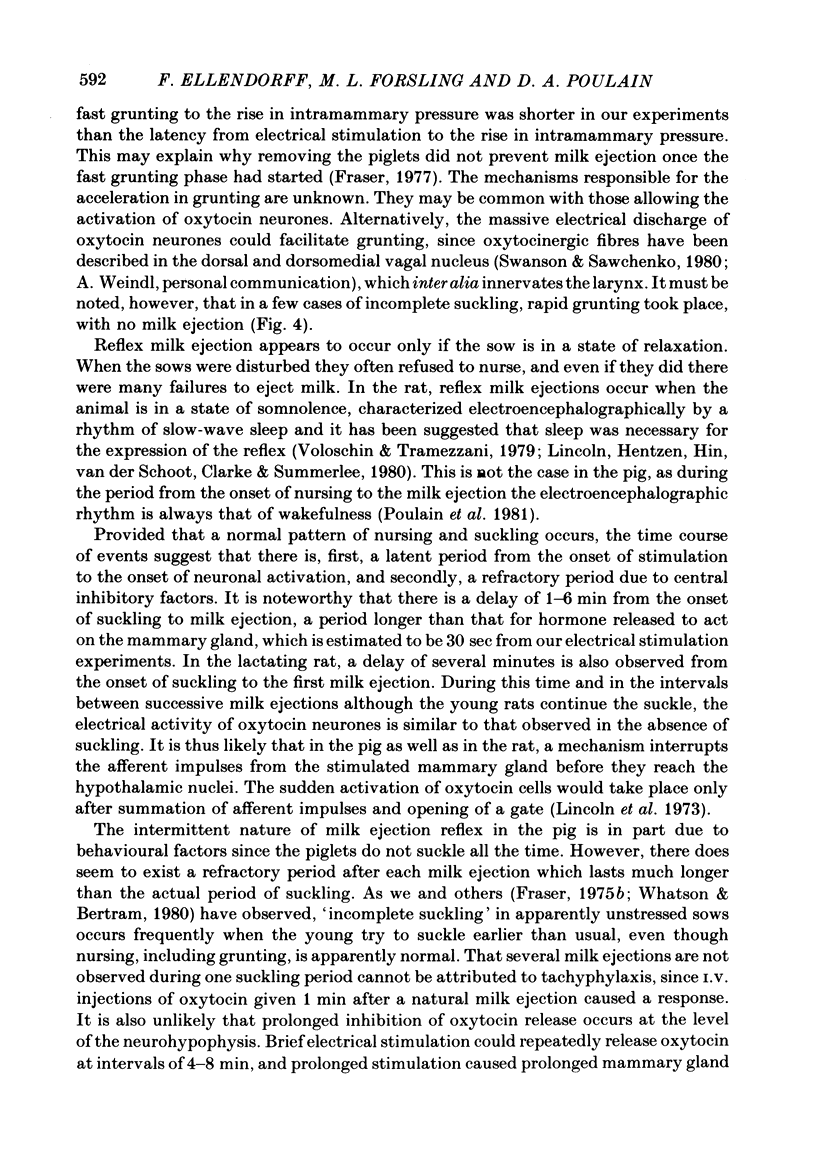


Selected References
These references are in PubMed. This may not be the complete list of references from this article.
- Bisset G. W., Clark B. J., Haldar J. Blood levels of oxytocin and vasopressin during suckling in the rabbit and the problem of their independent release. J Physiol. 1970 Mar;206(3):711–722. doi: 10.1113/jphysiol.1970.sp009039. [DOI] [PMC free article] [PubMed] [Google Scholar]
- CROSS B. A., HARRIS G. W. The role of the neurohypophysis in the milk-ejection reflex. J Endocrinol. 1952 Apr;8(2):148–161. doi: 10.1677/joe.0.0080148. [DOI] [PubMed] [Google Scholar]
- CROSS B. A. Neurohormonal mechanisms in emotional inhibition of milk ejection. J Endocrinol. 1955 Jan;12(1):29–37. doi: 10.1677/joe.0.0120029. [DOI] [PubMed] [Google Scholar]
- DOUGLAS W. W., RITCHIE J. M. Mammalian nonmyelinated nerve fibers. Physiol Rev. 1962 Apr;42:297–334. doi: 10.1152/physrev.1962.42.2.297. [DOI] [PubMed] [Google Scholar]
- Dreifuss J. J., Kalnins I., Kelly J. S., Ruf K. B. Action potentials and release of neurohypophysial hormones in vitro. J Physiol. 1971 Jul;215(3):805–817. doi: 10.1113/jphysiol.1971.sp009499. [DOI] [PMC free article] [PubMed] [Google Scholar]
- Ellendorff F., Parvizi N., Elsaesser F., Smidt D. The miniature pig as an animal model in endocrine and neuroendocrine studies of reproduction. Lab Anim Sci. 1977 Oct;27(5 Pt 2):822–830. [PubMed] [Google Scholar]
- Fabian M., Forsling M. L., Jones J. J., Lee J. The release, clearance and plasma protein binding of oxytocin in the anaesthetized rat. J Endocrinol. 1969 Feb;43(2):175–189. doi: 10.1677/joe.0.0430175. [DOI] [PubMed] [Google Scholar]
- Folley S. J., Knaggs G. S. Milk-ejection activity (oxytocin) in the external jugular vein blood of the cow, goat and sow, in relation to the stimulus of milking or suckling. J Endocrinol. 1966 Feb;34(2):197–214. doi: 10.1677/joe.0.0340197. [DOI] [PubMed] [Google Scholar]
- Forsling M. L., Aziz L. A., Miller M., Davies R., Donovan B. Conversion of triglycylvasopressin to lysine-vasopressin in man. J Endocrinol. 1980 May;85(2):237–244. doi: 10.1677/joe.0.0850237. [DOI] [PubMed] [Google Scholar]
- Forsling M. L., Taverne M. A., Parvizi N., Elsaesser F., Smidt D., Ellendorff F. Plasma oxytocin and steroid concentrations during late pregnancy, parturition and lactation in the miniature pig. J Endocrinol. 1979 Jul;82(1):61–69. doi: 10.1677/joe.0.0820061. [DOI] [PubMed] [Google Scholar]
- Fraser D. The nursing and suckling behaviour of pigs. I. The importance of stimulation of the anterior teats. Br Vet J. 1973 Jul-Aug;129(4):324–336. doi: 10.1016/s0007-1935(17)36434-5. [DOI] [PubMed] [Google Scholar]
- Fraser D. The nursing and suckling behaviour of pigs. III. Behaviour when milk ejection is elicited by manual stimulation of the udder. Br Vet J. 1975 Jul-Aug;131(4):416–426. doi: 10.1016/s0007-1935(17)35237-5. [DOI] [PubMed] [Google Scholar]
- Fraser D. The nursing and suckling behaviour of pigs. IV. The effect of interrupting the sucking stimulus. Br Vet J. 1975 Sep-Oct;131(5):549–559. doi: 10.1016/s0007-1935(17)35187-4. [DOI] [PubMed] [Google Scholar]
- Ishida A. The oxytocin release and the compound action potential evoked by electrical stimulation on the isolated neurohypophysis of the rat. Jpn J Physiol. 1970 Feb 15;20(1):84–96. doi: 10.2170/jjphysiol.20.84. [DOI] [PubMed] [Google Scholar]
- Lincoln D. W., Hentzen K., Hin T., van der Schoot P., Clarke G., Summerlee A. J. Sleep: a prerequisite for reflex milk ejection in the rat. Exp Brain Res. 1980 Jan;38(2):151–162. doi: 10.1007/BF00236736. [DOI] [PubMed] [Google Scholar]
- Lincoln D. W., Hill A., Wakerley J. B. The milk-ejection reflex of the rat: an intermittent function not abolished by surgical levels of anaesthesia. J Endocrinol. 1973 Jun;57(3):459–476. doi: 10.1677/joe.0.0570459. [DOI] [PubMed] [Google Scholar]
- Lincoln D. W., Wakerley J. B. Electrophysiological evidence for the activation of supraoptic neurones during the release of oxytocin. J Physiol. 1974 Oct;242(2):533–554. doi: 10.1113/jphysiol.1974.sp010722. [DOI] [PMC free article] [PubMed] [Google Scholar]
- Mikiten T. M., Douglas W. W. Effect of calcium and other ions on vasopressin release from rat neurohypophyses stimulated electrically in vitro. Nature. 1965 Jul 17;207(994):302–302. doi: 10.1038/207302a0. [DOI] [PubMed] [Google Scholar]
- Nordmann J. J., Dreifuss J. J. Hormone release evoked by electrical stimulation of rat neurohypophyses in the absence of action potentials. Brain Res. 1972 Oct 27;45(2):604–607. doi: 10.1016/0006-8993(72)90491-x. [DOI] [PubMed] [Google Scholar]
- Poulain D. A., Rodriguez F., Ellendorff F. Sleep is not a prerequisite for the milk ejection reflex in the pig. Exp Brain Res. 1981;43(1):107–110. doi: 10.1007/BF00238817. [DOI] [PubMed] [Google Scholar]
- Poulain D. A., Wakerley J. B. Electrophysiology of hypothalamic magnocellular neurones secreting oxytocin and vasopressin. Neuroscience. 1982 Apr;7(4):773–808. doi: 10.1016/0306-4522(82)90044-6. [DOI] [PubMed] [Google Scholar]
- Skowsky W. R., Rosenbloom A. A., Fisher D. A. Radioimmunoassay measurement of arginine vasopressin in serum: development and application. J Clin Endocrinol Metab. 1974 Feb;38(2):278–287. doi: 10.1210/jcem-38-2-278. [DOI] [PubMed] [Google Scholar]
- Swanson L. W., Sawchenko P. E. Paraventricular nucleus: a site for the integration of neuroendocrine and autonomic mechanisms. Neuroendocrinology. 1980 Dec;31(6):410–417. doi: 10.1159/000123111. [DOI] [PubMed] [Google Scholar]
- Voloschin L. M., Tramezzani J. H. Milk ejection reflex linked to slow wave sleep in nursing rats. Endocrinology. 1979 Nov;105(5):1202–1207. doi: 10.1210/endo-105-5-1202. [DOI] [PubMed] [Google Scholar]
- WHITTLESTONE W. G. The milk-ejecting activity of extracts of the posterior pituitary gland. J Endocrinol. 1952 Apr;8(2):89–95. doi: 10.1677/joe.0.0080089. [DOI] [PubMed] [Google Scholar]
- Wakerley J. B., Dyball R. E., Lincoln D. W. Milk ejection in the rat: the result of a selective release of oxytocin. J Endocrinol. 1973 Jun;57(3):557–558. doi: 10.1677/joe.0.0570557. [DOI] [PubMed] [Google Scholar]
- Wakerley J. B., Lincoln D. W. The milk-ejection reflex of the rat: a 20- to 40-fold acceleration in the firing of paraventricular neurones during oxytocin release. J Endocrinol. 1973 Jun;57(3):477–493. doi: 10.1677/joe.0.0570477. [DOI] [PubMed] [Google Scholar]
- Whittemore C. T., Fraser D. The nursing and suckling behaviour of pigs. II. Vocalization of the sow in relation to suckling behaviour and milk ejection. Br Vet J. 1974 Jul-Aug;130(4):346–356. doi: 10.1016/s0007-1935(17)35837-2. [DOI] [PubMed] [Google Scholar]
- Zarrow M. X., Denenberg V. H., Anderson C. O. Rabbit: frequency of suckling in the pup. Science. 1965 Dec 31;150(3705):1835–1836. doi: 10.1126/science.150.3705.1835. [DOI] [PubMed] [Google Scholar]


